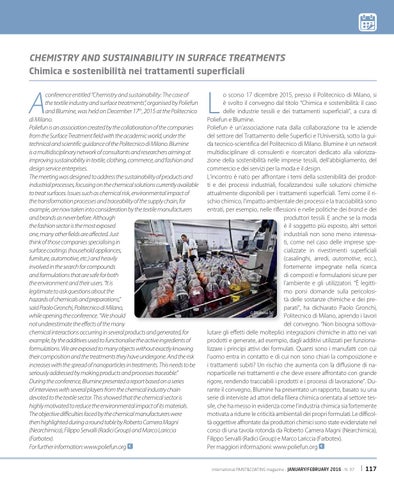by Paola Giraldo
CHEMISTRY AND SUSTAINABILITY IN SURFACE TREATMENTS Chimica e sostenibilità nei trattamenti superficiali
A
conference entitled “Chemistry and sustainability: The case of the textile industry and surface treatments”, organised by Poliefun and Blumine, was held on December 17th, 2015 at the Politecnico di Milano. Poliefun is an association created by the collaboration of the companies from the Surface Treatment field with the academic world, under the technical and scientific guidance of the Politecnico di Milano. Blumine is a multidisciplinary network of consultants and researchers aiming at improving sustainability in textile, clothing, commerce, and fashion and design service enterprises. The meeting was designed to address the sustainability of products and industrial processes, focusing on the chemical solutions currently available to treat surfaces. Issues such as chemical risk, environmental impact of the transformation processes and traceability of the supply chain, for example, are now taken into consideration by the textile manufacturers and brands as never before. Although the fashion sector is the most exposed one, many other fields are affected. Just think of those companies specialising in surface coatings (household appliances, furniture, automotive, etc.) and heavily involved in the search for compounds and formulations that are safe for both the environment and their users. “It is legitimate to ask questions about the hazards of chemicals and preparations,” said Paolo Gronchi, Politecnico di Milano, while opening the conference. “We should not underestimate the effects of the many chemical interactions occurring in several products and generated, for example, by the additives used to functionalise the active ingredients of formulations. We are exposed to many objects without exactly knowing their composition and the treatments they have undergone. And the risk increases with the spread of nanoparticles in treatments. This needs to be seriously addressed by making products and processes traceable.” During the conference, Blumine presented a report based on a series of interviews with several players from the chemical industry chain devoted to the textile sector. This showed that the chemical sector is highly motivated to reduce the environmental impact of its materials. The objective difficulties faced by the chemical manufacturers were then highlighted during a round table by Roberto Camera Magni (Nearchimica), Filippo Servalli (Radici Group) and Marco Lariccia (Farbotex). For further information: www.poliefun.org ‹
L
o scorso 17 dicembre 2015, presso il Politecnico di Milano, si è svolto il convegno dal titolo “Chimica e sostenibilità: il caso delle industrie tessili e dei trattamenti superficiali”, a cura di Poliefun e Blumine. Poliefun è un’associazione nata dalla collaborazione tra le aziende del settore del Trattamento delle Superfici e l’Università, sotto la guida tecnico-scientifica del Politecnico di Milano. Blumine è un network multidisciplinare di consulenti e ricercatori dedicato alla valorizzazione della sostenibilità nelle imprese tessili, dell’abbigliamento, del commercio e dei servizi per la moda e il design. L’incontro è nato per affrontare i temi della sostenibilità dei prodotti e dei processi industriali, focalizzandosi sulle soluzioni chimiche attualmente disponibili per i trattamenti superficiali. Temi come il rischio chimico, l’impatto ambientale dei processi e la tracciabilità sono entrati, per esempio, nelle riflessioni e nelle politiche dei brand e dei produttori tessili. E anche se la moda è il soggetto più esposto, altri settori industriali non sono meno interessati, come nel caso delle imprese specializzate in rivestimenti superficiali (casalinghi, arredi, automotive, ecc.), fortemente impegnate nella ricerca di composti e formulazioni sicure per l’ambiente e gli utilizzatori. “È legittimo porsi domande sulla pericolosità delle sostanze chimiche e dei preparati”, ha dichiarato Paolo Gronchi, © Blumine Srl Politecnico di Milano, aprendo i lavori del convegno. “Non bisogna sottovalutare gli effetti delle molteplici integrazioni chimiche in atto nei vari prodotti e generate, ad esempio, dagli additivi utilizzati per funzionalizzare i principi attivi dei formulati. Quanti sono i manufatti con cui l’uomo entra in contatto e di cui non sono chiari la composizione e i trattamenti subiti? Un rischio che aumenta con la diffusione di nanoparticelle nei trattamenti e che deve essere affrontato con grande rigore, rendendo tracciabili i prodotti e i processi di lavorazione”. Durante il convegno, Blumine ha presentato un rapporto, basato su una serie di interviste ad attori della filiera chimica orientata al settore tessile, che ha messo in evidenza come l’industria chimica sia fortemente motivata a ridurre le criticità ambientali dei propri formulati. Le difficoltà oggettive affrontate dai produttori chimici sono state evidenziate nel corso di una tavola rotonda da Roberto Camera Magni (Nearchimica), Filippo Servalli (Radici Group) e Marco Lariccia (Farbotex). Per maggiori informazioni: www.poliefun.org ‹
international PAINT&COATING magazine - JANUARY/FEBRUARY 2016 - N. 37
117
